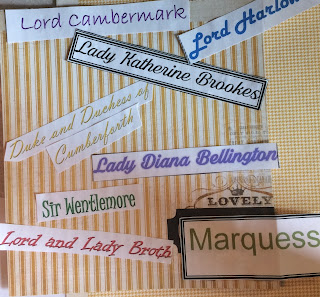What is in a title? It turns
out during the late 1700’s and early 1800’s . . . a lot. Men’s titles dictated
what the women in his family would be called.
For instance if your father was a
Duke, the highest rank under the King, both he and his wife the Duchess would
be called Your Grace, though people close to them would be able to call them
Duchess or Duke. All of the Duke’s daughters are given the title Lady, then
their first name and then their surname. These titles continue to all daughters
who have fathers that are either a Duke,
Marquess or Earl.
The Earl of Mistlewatch is
then shortened to Earl Mistlewatch, his wife would be the Countess. So any one
calling on him would call him the Earl of Mistlewatch or Lord Mistlewatch or Mistlewatch.
His wife would be the Countess of Mistlewatch or Lady Mistlewatch, and sign letters
to her closest friends, Constance Mistlewatch. His daughter would be called for
instance Lady Helen Mistlewatch.
To make matters more
interesting if Lady Helen Mistlewatch marries a commoner, she retains her title
but if Lady Helen marries the Earl of Heinrich she becomes the Countess of Heinrich,
Lady Heinrich. If she marries the holder of a courtesty title, then she may use
his title or her birth title as she wishes.
So the Duke of Edinburough’s
daughter, Lady Mary Edinburough will never be called Lady Edinburough. That is
her mother’s title. The only exception being if her father has no sons and she marries
the heir to his title. Then she will be Lady Edinburough. But if that does not
occur she will be called Lady Mary until she marries.
To complicate matters the son of Earls, Marquesses and Dukes will take the title the father had before he became the higher title. So your father may be called Duke and the son from infancy would be called the Marquess of another property/land that the family holds. ie Marquess Somerset.
It is great to keep a chart of
who is who and what they should be called for it can be very confusing even within a family of who is who.


 It is always such a wonderful time
spending it with the people you love. This year without my Dad made it
hard. Not one of us was looking forward to Christmas Eve. But something
interesting, something that
It is always such a wonderful time
spending it with the people you love. This year without my Dad made it
hard. Not one of us was looking forward to Christmas Eve. But something
interesting, something that  can only be explained as supernatural happened.
Being together somehow made it easier.
can only be explained as supernatural happened.
Being together somehow made it easier. 



























